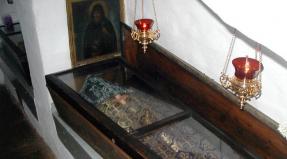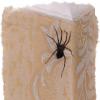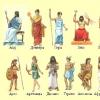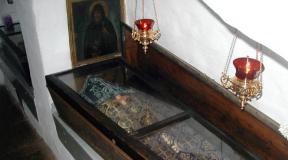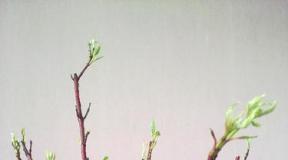Kikimora black and white. Who is a kikimora? The magic of objects associated with kikimora
Kikimora is a spirit that lives in houses. She is considered a wife. There is also the Swamp Kikimora. Its name comes from its place of residence. She lives in a swamp and is a wife. Swamp Kikimora is similar to her domestic sister. The only differences are skin color and hair length.
Kikimora lives behind the stove or in a barn with animals. There she can cut them secretly. She can live with the chickens in the chicken coop and pluck them there. Kikimora can scare a child and confuse the owners' yarn. She loves to play pranks at night: she knocks pots in the stove, throws bows, and can roll under a person’s feet and drop him. But sometimes, Kikimora is attacked by a whim, and she begins to do good deeds. She can rock the baby, sweep the floor or wash the dishes. She will definitely break some dishes.
Kikimora was believed in ancient times. The name comes from the famous goddess Morena. She could also be called Mara or Mora. Then the root “kik” was added to this name, which means hunchback.
Kikimora looks old and ugly. Has a thin body and a small head. The hair is always disheveled, the face is ugly, and instead of clothes there are rags. In some places, Kikimora was presented as a young, beautiful girl with a long braid and completely naked, and sometimes as a simple peasant woman. Sometimes you can meet a masculine Kikimora. But this is extremely rare.
Kikimora usually does not appear to people. It was believed that whoever saw her would die. She indicates her existence only with sounds: knocking, crying of a child, dancing and singing. Sometimes, people in the house begin to imagine different animals: a pig, a hare, a dog. This is also the work of Kikimora.
It was believed that a child who died from an abortion or a girl who died before could become a Kikimora. Many believed that if the number of Kikimoras and abortions coincided, then they would wait for their mother to take her soul to hell.
Kikimora became girls who were born from a fiery serpent, stolen or exchanged by evil spirits. Kikimoras often appear where murders were committed, near swamps, where there is an accumulation of negative energy. Kikimora could have been unleashed by sorcerers or simple malicious people.
Kikimora's birthday is March 2. This day is considered the day of the goddess Mara. On this day we said goodbye to winter and welcomed spring.
On this day, we washed all the dishes at home and threw out all the old and broken ones. From the house to the Well or crossroads, they swept the path and threw out dishes and old clothes there.
Sometimes, Kikimora could annoy the owners so much that they moved to a new house. But in order not to change their lives so radically, some tried to appease Kikimora or drive her out completely. Animal hair helped, which had to be inserted under the pole along with incense. At the same time, a special conspiracy was read.
You can also look for a small doll at home. If one is found, then you need to burn it over an open fire, and then Kikimora will leave.
Although kikimoras harm people, they are considered much kinder than brownies. She tries to instill unreasonable fear in people, to get them out of the house, but most just laugh at her and get angry.
In mythology, there are very often references to creatures such as. Their other names are shishiga or shishimora. Who they are, where they came from, and how they interact with people still interests people.
Who is Kikimora swamp?
Initially, the word “mora” appeared, and then “kiki” was added to it, which meant hunchback. The word kikimora is used to describe the wife who protects the human home. She is usually presented as a woman with matted hair and very ugly. Her habitat is considered to be home.
The swamp kikimora can be considered its sister. In some ways they are similar in appearance, in character, and in behavior, but there are also certain differences. Swamp kikimora- This is the wife of a devil who lives deep in the swamps. In contrast, they have green skin and very long hair covered with mud. Swamp kikimora They rarely show themselves to people, and they are also very afraid of sunlight, because under bright light their skin takes on a green tint. So they live in remote, swampy places and fool travelers passing through the forest.
What do swamp kikimoras look like?
Just like household perfumes, they take on the image of an ugly woman with small eyes, thin lips and a hooked nose. There may be warts on her face. The hair of such a kikimora is very long. She weaves mud and marsh plants into them. Dressing up swamp kikimores, usually in something like a network. She also really loves various furs, which she also uses as an outfit.
An ordinary person rarely sees this creature. Usually appears in front of those who themselves were lured into swampy swamps. They appear to frighten and completely disorganize a drowning person.
The appearance of the marsh kikimora
Very often you can hear that women with a bad, grumpy character who are constantly dissatisfied with everything are called kikimora. This comparison did not appear by chance. This wickedness really has a very bad temper.
Where did swamp kikimoras come from?
 Several versions have been put forward regarding this matter. Swamp kikimors can become babies who were hated and cursed by their mother, as well as drowned and unbaptized female children. Also, a fiery serpent flew to widows and girls yearning for their beloved, which turned into a young man and seduced the unfortunate woman. Such relationships produced children who became kikimoras.
Several versions have been put forward regarding this matter. Swamp kikimors can become babies who were hated and cursed by their mother, as well as drowned and unbaptized female children. Also, a fiery serpent flew to widows and girls yearning for their beloved, which turned into a young man and seduced the unfortunate woman. Such relationships produced children who became kikimoras.
Carpenters and stove makers who have not been paid by the owner for their work can release harmful creatures into the house. After the payment was made, everything fell into place, and no one knocked or rattled the grips.
In the Urals there is a belief that children who go into swampy places are stolen by hummocks - these are swamp evil spirits. She hides in the mud all day, showing only her fluffy hair. Towards evening, swamp hunters come out and look for their prey. Noticing the child, they wrapped their arms around him like ropes and pulled him into the quagmire. After this, another swamp kikimora appeared.
In remote villages, strange encounters between people and swamp wickedness still occur, especially in those places where the swamps are terrible and impassable. Usually such stories involve the disappearance of children. In a Ural village, a girl who disappeared in a swamp appeared only a few years later. She continued to live unsociablely, and no one wanted to communicate with her. When the opportunity presented itself to save a man lost in a swamp, she did it. But the rescued man had a feeling that something mystical and unreal had happened to him. He lost track of time, was left without a basket of mushrooms and berries, and right next to the village. While a minute ago I was drowning in a quagmire. Such mysterious stories happen to people quite often, but they are rarely voiced.
The connection between the swamp kikimora and the gods
The swamp kikimoras and their domestic sisters have their own birthday, which is associated with the appearance of the goddess Mara. On the second of March, winter ends and spring comes. Special rituals were associated with this event.
First of all, you need to clean your home. An old broom was used as a ritual broom, which was swept in all corners. It was then wrapped up and thrown away from the house, and sometimes burned to the ground. In addition to the house, it was necessary to sweep the entire yard and paths to the well or reservoir, and the intersection was also used as a landmark.
Old clothes and broken dishes were thrown out of the house as far as possible. Most often it was left at a crossroads or at a well.
Some owners were forced to leave their home and go to live in another place when the kikimoras began to take them out and survive. People sometimes tried to drive this obsessive spirit out of their homes. In this case, it was impossible to do without church incense. They sprinkled animal hair with it and stuck the amulet between the boards. There was a magical conspiracy for this case.
Swamp kikimora and her pranks
 It is impossible to remove swamp kikimoras from their native swamps, and no one tried to do this, since even the most disastrous places must have their own owner. very secretive, they never deliberately show themselves to people, but their presence is felt. When a person finds himself in a swamp, he often hears characteristic sounds. Gurgling, crackling, crying of a child or scream of a woman, howling of a dog and so on are very often heard from the swamps. Who can make such sounds?
It is impossible to remove swamp kikimoras from their native swamps, and no one tried to do this, since even the most disastrous places must have their own owner. very secretive, they never deliberately show themselves to people, but their presence is felt. When a person finds himself in a swamp, he often hears characteristic sounds. Gurgling, crackling, crying of a child or scream of a woman, howling of a dog and so on are very often heard from the swamps. Who can make such sounds?
Scientists claim that gases emerge from the depths of the swamp, which can produce a certain background sound, but not everything can be justified by this phenomenon. It is difficult to confuse human crying with the release of methane.
Usually, a person who hears the calling cry of his own kind tries to provide help, without thinking about the danger that lurks under the green mosses. Having stepped on such a place, the savior begins to plunge into the marshy slurry, from which there is practically no escape, while crying and groans can turn into demonic laughter. At this moment, the drowning man sees a terrible sight. An incomprehensible creature with green skin, long, tangled hair and dressed in an outfit woven from algae appears from the opening mosses and swamps. Swamp kikimora appears at the last moment to see the agony of the dying man and frighten him so that there is no strength left to resist the quagmire.
Swamp Spirit Helpers
The insidious and terrible for humans swamp kikimora has several assistants and servants who are afraid of it and play various dirty tricks on people. Bolotniki and bogeymen, rats and sinister creatures pose a danger to people.
It is not surprising for those who have been to swamps to see such a phenomenon as the appearance of lights. Blue lights, flickering and flashing out of nowhere, frighten travelers and attract them. Since those who do not know that there is a swamp ahead, go to the light as to a human dwelling. These very lights, according to legend, light swamp kikimores and their closest assistants.
According to data that has not been fully proven and researched, swamps are considered the cradle of all life on earth. About two thousand mummies have already been found there. And in the depths of the peat you can find imprints of creatures that previously existed in nature. A person feels very uncomfortable in these places. He begins to experience horror, a feeling of fear and weakness. Perhaps this is due to the numerous secrets hidden by the swamp, or maybe due to the presence of evil spirits there.
Chicken God
Other items
(kikimara, shishimora, shishimara, neighbor, mara) - an East Slavic female mythological character who lives in a person’s home, causing harm, damage and minor troubles to the household and people.
Origin of the name
According to S. Maksimov, the word kikimora is two-part: kick And pestilence.
- "kick"- bird cry;
- "pestilence"- gloominess, darkness, fog, ghost.
Alternative nickname - "shishimora" There is a taboo name for kikimora, as “shisha” was the name for evil spirits. There is a theory that it goes back to verbs of Russian dialect origin “shishit, shishat” - “to swarm, move, do furtively.”
Mythological image
According to Slavic beliefs, kikimors settle in premises if the “wrong” dead person was buried under them: the corpse of a child, a hanged or inveterate dead person, also in a house where a child died for some reason. There are known beliefs about kikimors as children kidnapped or exchanged by evil spirits. Sometimes it was believed that kikimoras appear from a love affair between girls and an evil spirit in the form of a fiery serpent. May be sent by a sorcerer.
It was believed that kikimores love to joke with people and sometimes appear in the form of a child abandoned on the road; picked up and warmed by people, they run away, laughing at them. She was represented in different ways: as the mistress of the hut, the wife of a brownie or a goblin. The swamp or forest kikimora was accused of kidnapping children, leaving behind an enchanted log in their place. Her presence in the house was determined by wet footprints. It was believed that one could protect oneself from kikimora by prayer or, conversely, by swearing.
Kikimor's favorite pastime is weaving and yarn. On the night before Christmas, they ripple and burn the tow, left without prayer by absent-minded spinners on their spinning wheels. This feature in the activities of the kikimora makes her similar to the pagan goddess Mokoshya, the influence of whose cult probably left its mark on the image of this household spirit. Occasionally, the kikimora was even considered a female assistant in baking bread, washing dishes, caring for livestock and lulling children to sleep.
In the Vologda province it was believed that kikimors give birth to their naughty children during Christmas time. The shulikuns will fly out of the house through the chimney into the street, where they remain until Epiphany.
It was believed that kikimora could be seen before special events that were significant for family members, often on the threshold. If she cries or loudly knocks with bobbins for lace weaving, this portends trouble; if she spins, then someone’s death should be expected. If you ask a kikimora, she can answer by knocking.
A caught kikimora could be turned into a human if the hair on its crown was cut in the shape of a cross. However, some defect reminiscent of the past will always remain: stuttering, stooped posture, weak mind.
In the image of the kikimora we have the remnant of some lower deity of the ancient Slavs. Belief in them is probably in connection with the cult of the souls of deceased ancestors. Some people identify kikimora with the French spirit cauchemar.
Appearance and description
People imagined kikimoras in the form of ugly dwarfs or babies with a head the size of a thimble and a body as thin as a straw. They have the ability to be invisible, run fast and see long distances, wear neither clothes nor shoes - these are forever young girls, small and restless. According to other beliefs, a kikimora looks like a small, crooked and ugly old woman, dressed in torn rags, funny and sloppy, who is afraid that she will be carried away by the wind, and therefore does not leave the house. Occasionally, the kikimora was represented in the guise of a man. Occasionally in the guise of a maiden with loose hair or a long braid, completely undressed or in a single-color shirt. Occasionally - in the guise of a married woman in a military uniform. There were beliefs that the kikimora appeared to look like a dog, pig, duck, and also like a hare and hamster.
Activities and lifestyle
Kikimors usually live behind the stove, under the floor, in the chicken coop, in the barn, or in the attic. They can also live in abandoned buildings, in the yard, in the bathhouse, on the threshing floors, even in the tavern. They hide from people during the day, are active at night, and sometimes bother their owners with noise and fuss. On quiet nights you can hear them jumping, spinning and twisting threads. They can spin the left yarn, but not from left to right, but vice versa, but more often they break and waste the threads, burn the tow, and tangle the wool that was thrown without a blessing. They sew poorly, the kikimora stitches are uneven, uneven: “You won’t get a shirt from a kikimora”(Russian proverb).
Kikimora's tricks
According to popular belief, kikimoras are a constant source of trouble; when they appear in the house, they do minor mischief: they disturb sleep by rustling, howling, squeaking, crying, breaking dishes, throwing off clothes, driving horses at night, trimming the feathers of chickens and wool from sheep:
Sometimes, in a fit of playfulness, kikimoras, like brownies, fall on their owners and strangle them at night, and can pull their hair. The following tale was popular:
One of the pranks of a kikimora is described in Alexei Tolstoy’s novel “Walking Through Torment”:
Textual analysis shows that A. N. Tolstoy used protocols of real interrogations of the Secret Chancellery. Based on them, we can conclude that the kikimora was noticed in 1722 and, therefore, is the oldest evil spirit recorded in St. Petersburg.
The magic of objects associated with kikimora
Kikimora dolls
There was a belief that kikimors were sent to the owners by stove makers or carpenters who were dissatisfied or offended when paying for the construction. A doll made from wood chips or sewn from rags, representing a kikimora, is placed somewhere in the house, often between logs or beams, after which a “planted kikimora” appears in the house, sending all sorts of obsessions to the owners: they are shown either a hare or a pig, now a dog, now a bull, I imagine songs and dances, doors open by themselves.
To stop the excesses of the kikimora, the planted doll had to be found and burned. Or throw it away in a remote area.
Chicken God
It was considered a universal amulet against kikimora « chicken god» - a black stone the size of a goose egg and with a hole of natural origin, a whole neck from a broken jug or a worn bast shoe. “Chicken God” in the Vologda region was also called "Kikimora one-eyed". On January 2 (15), Sylvester's Day, he was hung by a thread on the wall of the chicken coop to protect the chickens from brownies and kikimoras.
Other items
It was believed that the kikimora did not like juniper, from the branches of which they made a braid for the salt shaker so that the kikimora would not carry salt. Pots and other utensils were washed with fern infusion so that the kikimora would not touch them. In one 18th-century treatment book, it was suggested to put camel hair and incense in the house to get rid of kikimora.
Kikimora in the folk calendar
According to some local beliefs, the kikimora lives on the street or on the threshing floor until Christmas time, and then goes to God knows where. In the Vologda province it was believed that on Christmastide the kikimora gives birth to children. Newborns fly into the chimney onto the street, where they live until Epiphany; these are shulykans (shushkans). On Christmas festivities, the old women pretended to be “shishimor”: they put on torn clothes and sat on the floor with a long sharpened stick, dangling their legs from the beam and, placing a spinning wheel between their legs, they spun. The girls, laughing, grabbed them by the legs, and the “kikimora” fought them off with a stick. Sometimes the kikimora was portrayed by a guy dressed in an old woman’s rags and with a clay pot on his head, replacing a kokoshnik. After the pot was broken, the “kikimora” turned into an ordinary guy.
Saint Mariamne, whose memorial day is celebrated by the church on February 17 (March 2), was popularly called Maremyana-Kikimora and was often celebrated a day earlier - February 16 (March 1). “In Little Russia, a stuffed animal called mara or madder is apparently dragged through the streets when spring is welcomed (March 1) with the singing of stoneflies.”
On March 4 (17), on the day of “Gerasim Grachevnik”, the kikimora could survive from home; at this time they become quiet. To expel the kikimoras they used a conspiracy: “Oh, you goy, brownie kikimora, get out of the goryunin’s house quickly!”
Mythological imageKikimoras come from different origins:
- these are babies who died unbaptized, stillborns, premature babies, miscarriages, freaks without arms and legs
- children from a vicious relationship with a fiery serpent;
- children cursed by their parents and therefore kidnapped or exchanged by evil spirits.
Kikimors, as a rule, settle in premises if the corpse of a child, a hanged or uninveterate dead person was buried under them, or in a house where a child died for some reason. May be sent by a sorcerer.
Kikimoras love to joke with people and sometimes appear in the form of an abandoned child along the way; picked up and warmed by people, they run away, laughing at them. She was represented in different ways: as the mistress of the hut, the wife of a brownie or a goblin. The swamp or forest kikimora was accused of kidnapping children, leaving behind an enchanted log in their place. Her presence in the house could be easily determined by her wet footprints. One could defend oneself against kikimora with a word of prayer, invoking the name of God, or, conversely, with abuse.
Kikimor's favorite pastime is weaving and yarn. On the night before Christmas, they ripple and burn the tow, left without prayer by absent-minded spinners on their spinning wheels. This feature in the activities of the kikimora makes her similar to the pagan goddess Mokoshya, the influence of whose cult probably left its mark on the image of this household spirit. Occasionally, the kikimora was even considered a female assistant in baking bread, washing dishes, caring for livestock and lulling children to sleep.
It was believed that kikimora could be seen before special events that were significant for family members, often on the threshold. If she cries or loudly knocks with bobbins for lace weaving, this portends trouble; if she spins, then someone’s death should be expected. If you ask a kikimora, she can answer by knocking.
A caught kikimora could be turned into a human if the hair on its crown was cut in the shape of a cross. However, some defect reminiscent of the past will always remain: stuttering, stooped posture, weak mind.
In the person of kikimora we have the remnant of some lower deity of the ancient Slavs. Belief in them is probably in connection with the cult of the souls of deceased ancestors. Some people identify kikimora with the French spirit cauchemar.
Appearance and description
People imagine kikimoras in the form of ugly dwarfs or babies with a head the size of a thimble and a body as thin as a straw. They have the ability to be invisible, run fast and see long distances, wear neither clothes nor shoes - these are forever young girls, small and restless. According to other descriptions, the kikimora looks like a small, crooked and ugly old woman, dressed in torn rags, funny and sloppy, who is afraid that she will be carried away by the wind, and therefore does not leave the house. Occasionally, the kikimora was represented in the guise of a man. Occasionally in the guise of a maiden with loose hair or a long braid, completely undressed or in a single-color shirt. Occasionally - in the guise of a married woman in a military uniform. There are beliefs that the kikimora appeared to look like a dog, pig, duck, and also like a hare and hamster.
Activities and lifestyle
Due to their affinity with house spirits, kikimoras usually live behind the stove, under the floor, or in the attic. They can also live in abandoned buildings, in the yard, in the bathhouse, in the stable, on the threshing floor, in the chicken coop; even in a tavern. It hides from people during the day, is active at night, and sometimes annoys its owners with noise and fuss. On quiet nights you can hear them jumping, spinning and twisting threads. It can spin the left yarn, only not from left to right, but vice versa, but more often it breaks and wastes the threads, burns the tow, and tangles the wool that was thrown without a blessing. It sews poorly, the stitches of the kikimora are uneven and uneven: “You won’t get a shirt from a kikimora”(Russian proverb).

Kikimora's tricks
When they appear in the house, kikimoras are a constant source of trouble, they do minor mischief: they interfere with sleep by rustling, howling, squeaking, crying, breaking dishes, throwing onions from underground, throwing off clothes, driving horses at night, trimming feathers from chickens and wool from sheep:
One owner's kikimora severely tormented sheep, cut their wool, and no matter how hard they tried to get rid of it, nothing worked. Then the owners decided to move to another village. They hoped that the kikimora would remain in its old place. As things were put on the cart, the owner asked: “Did they take everything from the house?” And a thin voice came from the cart: “I don’t know if you took everything, but I took my scissors!”
Sometimes, in a fit of playfulness, kikimoras, like brownies, fall on their owners and strangle them at night, and can pull their hair. The following tale was popular:
In one hut there was a kikimora, she walked on the floor all night long and stomped her feet heavily. Then she began rattling dishes and breaking bowls. The owners had to leave this house, and it was left desolate. After some time, gypsies and a bear settled there. Kikimora, not knowing who she had contacted, attacked the bear, but he crushed her badly. Kikimora ran away from this house. When the owners found out that the house was no longer “scaring,” they returned there. A month later, the kikimora approached the house in the guise of an ordinary woman and asked the children: “Has the big cat left you?” “The cat is alive and brought kittens,” the guys answered her. Kikimora went back, muttering as she walked: “Now it’s really bad, the cat was angry, and with kittens you can’t approach her at all.”
Proverbs
There is a Russian proverb “You won’t get a shirt from Kikimora.” Probably this image overlaps with the general idea of stupid housewives who leave their yarn unfinished, sew untidy, and fuss about the house without visible results.
Kikimora lives behind the stove, in the attic, under the floor in a barn and in abandoned houses. Having settled in the house, she breaks dishes, scatters onions, plucks sheep wool and chicken feathers.
Different peoples in mythology have the same image of a spirit that comes at night and strangles a person. This is a Nightmare, personified in the image of Kikimora, dreams, torment, anxiety. I attribute these tricks to Kikimore - the suffocation of the owners in their sleep.
If the stove maker and carpenter were not paid for their work, offended, they could throw a sewn, disheveled doll - a little Kikimora - between the logs. Then the owners imagined cats, dogs, and various obsessions. To stop this, it was necessary to find and burn the “impaled kikimora.”
Folk calendar
According to the folk calendar, on January 15, Sylvester Day, chicken coops are cleaned and a talisman called the chicken god is hung in them. He protects the chickens from brownies and Kikimora.
Strong odors drive away all evil spirits. Therefore, in order to protect their home from Kikimora, people braided salt shakers with juniper, washed dishes with fern infusion, or placed camel hair and incense in the corners.
In the folk calendar, March 1 is celebrated as the day of Meremyana Kikimora. How Saint Mariamne could become Kikimora is quite difficult to explain.
Thus, the mythical Kikimora is a multifaceted image, responsible for both non-life-threatening pranks and suffocating nightmares that bring death. It is surprising that the word Kikimora is of Slavic origin, but has corresponding names for supernatural heroes among other peoples.
Perhaps it's just the image of a sloppy bore. But even in this case, many languages have similar correspondences to define this type of people. KIKIMORA(Shishimora) is a yard spirit that is considered evil and harmful to poultry. The usual place of settlement is chicken coops, those corners of barns where chickens roost. Stones are hung in chicken coops, so-called. “chicken gods” so that kikimors do not crush chickens. The kikimor's job is straightforward - plucking feathers from chickens and pointing a “spinner” at them (when they spin around like crazy and fall dead). Kikimors trample and burn the tow left at the spinning wheels without the blessing of the cross. Kikimors are represented as ugly dwarfs or babies, with a head the size of a thimble and a body as thin as a straw. They are endowed with the ability to be invisible, run quickly and see keenly into distant spaces; wander around without clothes or shoes, never grow old and love to knock, rattle, whistle and hiss. In the Vologda province, they are also credited with good qualities: in the summer they guard pea fields, patronize skillful and diligent housewives, lull little children to sleep at night, invisibly wash pots and provide various household services. On the contrary, they hate and scare lazy women. The name kikimora, which has become a swear word, is used in a wide variety of cases: this is the name of both an unsociable homebody and a woman who is very diligent in yarn. “- Ha! - a thin voice burst out, - ha! look! and the hat is on the pole...: Hee-hee!.. hee-hee! And he got crazy, tripping on a smooth place!.. I crushed the sides of the young winches... Ha! ha ha ha! I spat in Grandmother’s cabbage soup at dinner, and I put a bee in Grandfather’s beard. She whined and meowed under the kisses, hee!.. - Kikimora shook all over, hesitated, and grabbed her skinny tummy with laughter” (A.M. Remizov. “Fairy Tales”). “In enchanted swamps, kikimors live there, / They will tickle you until you hiccup and drag you to the bottom” (V.S. Vysotsky. “Song of Evil Spirits”)
On March 17, according to the folk calendar, the day of Gerasim the Rooker is celebrated - this is the only day of the year when, according to Russian folk belief, an evil spirit can be driven out of the house - kikimora, also popularly known as kikimra, kukimora, kikimorka, shishimora, shmyshka, igon.
According to the church calendar, this is the day of remembrance of St. Gerasim of Lycia and St. Gerasim, the first Vologda miracle worker. This holiday in Rus' coincided with the arrival of rooks, which is why it received such a popular name - the day of Gerasim the rook. There was a belief about this day:“Gerasim the rook-keeper will return the rook to Rus', and drive the kikimora out of holy Rus'”.
A belief is any ingrained opinion among the people, which is passed from mouth to mouth and accepted on faith, without evidence. Russian beliefs were both true and false, which are called superstitions. In the old days, beliefs were taken very seriously, especially those that lived among the people for many centuries, originating in the times of pagan Rus'. The most common beliefs were stories about various mysterious creatures - brownies, mermaids, goblin, kikimoras. Moreover, these were precisely beliefs, and not superstitions, since in the old days many people were ready to swear that they personally spoke with a brownie, and in the forest they met a goblin.
Kikimora is one of the varieties of brownie from ancient Russian belief. She was represented as a dwarf or a small woman. If she was depicted as a woman, then her head was small, about the size of a thimble, and her body was thin, like a straw. Her appearance was ugly, her clothes were sloppy and unkempt. If depicted as a dwarf, then it must have eyes of different colors:one for the evil eye, the other for mischief. Less often, the kikimora was represented as a girl with a long braid, naked or in a shirt.
Sometimes the kikimora was considered the wife of the brownie, and when he was away from home, she was entrusted with his responsibility to look after the household. The wife of the goblin was also called a kikimora - she was called a goblin or a swamp kikimora. She was depicted as a small, hunched old woman. This is the variety of kikimora images presented in ancient Russian beliefs.
The word “kikimora” is complex and consists of two parts. “Kiki” means “cry”, and “mora” is the name of the ancient Slavic evil spirit Mara (Mora), close in description and qualities to kikimora. This is one of the versions of the origin of the word “kikimora”.
The Russians believed that kikimora were sent by unkind people who wished harm to the owners of the house. It could have been “let in” when building a house by carpenters or stove makers. They secretly placed it in the house in the form of a doll figurine made from wood chips and rags, which is why over time a kikimora appeared in the house. But the kikimora could start on its own; such a house was called dysfunctional.
She lived in a house behind the stove, during the day she was engaged in spinning and weaving, and at night she began to misbehave. She broke dishes, stomped her feet, threw things around, but the next morning the owners found all the things in their places, safe and sound. She also loved to annoy the owners with her rustling, howling, crying, interfering with sleep, and to play dirty tricks on domestic animals, cutting off their fur and plucking the feathers of birds.
In the old days, it was believed that if a kikimora appeared in your eyes, then you should expect trouble in the house. She was a harbinger of the death of one of the family members.
They didn’t like kikimoras and tried to get rid of them by any means, which was extremely difficult. Just on Gerasim Day it was believed that they became quiet and harmless, and then they could be kicked out of the house. On other days, people protected themselves from kikimora with the help of prayers and amulets.
The best amulet against kikimora, so that it does not take root in the house, was the “chicken god” - a stone with a natural hole created by nature. They also used the neck of a broken jug with a piece of red cloth, which was hung over a chicken roost so that the kikimora would not torment the birds.
She is afraid of the juniper kikimora, the branches of which were hung throughout the house, especially carefully protecting the salt shakers so that at night she would not spill the salt, which in the old days was very expensive. And if the kikimora was annoying with the rattling of dishes, then it was necessary to wash it with water infused with fern.
When expelling the kikimora, the healer who drove her out of the house used a special spell:
Come out, kikimora-brownie, from Goryunin’s house,
otherwise they’ll beat you up with hot rods,
will be burned with blazing fire,
will be filled with black resin.
My word is firm. Amen.
It was imperative to find a doll or foreign object in the house, with the help of which the kikimora was sent to the family. This item should have been carefully taken out of the house and thrown away, or best of all, burned. There is still a sign that if a person wants to harm another, he leaves a charmed object in his house, and in order to remove the damage, it is necessary to get rid of this object.
According to popular beliefs, if you sweep the floors in a house with a wormwood broom, then evil spirits will not appear, including kikimora. The belief is based on the attitude towards wormwood as one of the amulets. People believed that the pungent smell of this herb repels evil spirits and evil people.Legend of Kikimora:
According to the mythological beliefs of the Eastern Slavs, it is the evil spirit of the house. According to the definition in Vladimir Dahl's dictionary, kikimora is a type of brownie. Some researchers of the life of the Russian people believe that a kikimora is the wife of a brownie.
Our ancestors considered her the evil deity of nightmares, and later - the evil spirit of the peasant hut. Kikimoras are born from the Fiery Serpent, and evil spirits transport them to distant lands, to evil sorcerers, where they learn all kinds of evil magic. In appearance, the kikimora is thin, small, the head is the size of a thimble, and the body is no thicker than a straw.
Stealthily, the kikimora sneaks into a peasant hut and settles behind the stove. From here she goes out at night to play pranks with spindles, a spinning wheel, knitting, and started yarn. He takes the handicraft and sits in his favorite place - in the corner to the right of the entrance, near the stove. Whether the kikimora sits or spins, it constantly bounces in place. The bobbins are knocking, the spindle is whistling throughout the hut, the threads are spinning, but even though the kikimora works all night, there is no sense in its work. He will tangle the threads, tear the yarn, crumple the tow, and then hide behind the stove to knock and squeak there, scaring small children. But this is still so, mischief! Now, if he dislikes someone, he will drive everyone out of the hut with his whims. Nothing then suits Kikimore’s heart: the stove is in the wrong place, the table is in the wrong corner, and the bench is on the wrong wall. Everything in the house then falls and collapses, dishes break, milk turns sour, pies burn. And if she leaves the hut to live in the chicken coop, she will pluck the feathers of all the chickens! You can, of course, hang a “chicken god” in the chicken coop - a stone with a natural through hole, which was considered a talisman. You can wash everything in the hut with a tincture of bitter fern root - kikimora loves it very much and can leave it alone if you please. But the best and most reliable thing is to call a healer on Gerasim the Rook (March 4, old style) and use special, secret conspiracies to drive out the uninvited guest, so that she forgets the way to the house!
At the same time, people also believed that kikimora helps skilled housewives, and only harms the lazy and careless.
Kikimora(kikimara, shishimora, shishimara, neighbor, mara, etc.) - a predominantly negative character in Slavic mythology, one of the types of brownie.
Kikimoras come from different origins:
- these are babies who died unbaptized, stillborns, premature babies, miscarriages, freaks without arms and legs
- children from a vicious relationship with a fiery serpent;
- children cursed by their parents and therefore kidnapped or exchanged by evil spirits.
Kikimors, as a rule, settle in premises if the corpse of a child, a hanged or uninveterate dead person was buried under them, or in a house where a child died for some reason. May be sent by a sorcerer.
Kikimoras love to joke with people and sometimes appear in the form of an abandoned child along the way; picked up and warmed by people, they run away, laughing at them. She was represented in different ways: as the mistress of the hut, the wife of a brownie or a goblin. The swamp or forest kikimora was accused of kidnapping children, leaving behind an enchanted log in their place. Her presence in the house could be easily determined by her wet footprints. One could defend oneself against kikimora with a word of prayer, invoking the name of God, or, conversely, with abuse.
Kikimor's favorite pastime is weaving and yarn. On the night before Christmas, they ripple and burn the tow, left without prayer by absent-minded spinners on their spinning wheels. This feature in the activities of the kikimora makes her similar to the pagan goddess Mokoshya, the influence of whose cult probably left its mark on the image of this household spirit. Occasionally, the kikimora was even considered a female assistant in baking bread, washing dishes, caring for livestock and lulling children to sleep.
It was believed that kikimora could be seen before special events that were significant for family members, often on the threshold. If she cries or loudly knocks with bobbins for lace weaving, this portends trouble; if she spins, then someone’s death should be expected. If you ask a kikimora, she can answer by knocking.
A caught kikimora could be turned into a human if the hair on its crown was cut in the shape of a cross. However, some defect reminiscent of the past will always remain: stuttering, stooped posture, weak mind.
In the person of kikimora we have the remnant of some lower deity of the ancient Slavs. Belief in them is probably in connection with the cult of the souls of deceased ancestors.
Description
People imagine kikimoras in the form of ugly dwarfs or babies with a head the size of a thimble and a body as thin as a straw. They have the ability to be invisible, run fast and see long distances, wear neither clothes nor shoes - these are forever young girls, small and restless. According to other descriptions, the kikimora looks like a small, crooked and ugly old woman, dressed in torn rags, funny and sloppy, who is afraid that she will be carried away by the wind, and therefore does not leave the house. Occasionally, the kikimora was represented in the guise of a man. Occasionally in the guise of a maiden with loose hair or a long braid, completely undressed or in a single-color shirt. Occasionally - in the guise of a married woman in a military uniform. There are beliefs that the kikimora appeared to look like a dog, pig, duck, and also like a hare and hamster.
Due to their affinity with house spirits, kikimoras usually live behind the stove, under the floor, or in the attic. They can also live in abandoned buildings, in the yard, in the bathhouse, in the stable, on the threshing floor, in the chicken coop; even in a tavern. It hides from people during the day, is active at night, and sometimes annoys its owners with noise and fuss. On quiet nights you can hear them jumping, spinning and twisting threads. It can spin the left yarn, only not from left to right, but vice versa, but more often it breaks and wastes the threads, burns the tow, and tangles the wool that was thrown without a blessing. It sews poorly, the stitches of the kikimora are uneven and uneven:
“You won’t get a shirt from a kikimora”
(Russian proverb)
When they appear in the house, kikimoras are a constant source of trouble, they do minor mischief: they interfere with sleep by rustling, howling, squeaking, crying, breaking dishes, throwing onions from underground, throwing off clothes, driving horses at night, trimming feathers from chickens and wool from sheep:
When they appear in the house, kikimoras are a constant source of trouble, they do minor mischief: they interfere with sleep by rustling, howling, squeaking, crying, breaking dishes, throwing onions from underground, throwing off clothes, driving horses at night, trimming feathers from chickens and wool from sheep:
One owner's kikimora severely tormented sheep, cut their wool, and no matter how hard they tried to get rid of it, nothing worked. Then the owners decided to move to another village. They hoped that the kikimora would remain in its old place. As things were put on the cart, the owner asked: “Did they take everything from the house?” And a thin voice came from the cart: “I don’t know if you took everything, but I took my scissors!”
Sometimes, in a fit of playfulness, kikimoras, like brownies, fall on their owners and strangle them at night, and can pull their hair. The following tale was popular:
In one hut there was a kikimora, she walked on the floor all night long and stomped her feet heavily. Then she began rattling dishes and breaking bowls. The owners had to leave this house, and it was left desolate. After some time, gypsies and a bear settled there. Kikimora, not knowing who she had contacted, attacked the bear, but he crushed her badly. Kikimora ran away from this house. When the owners found out that the house was no longer “scaring,” they returned there. A month later, the kikimora approached the house in the guise of an ordinary woman and asked the children: “Has the big cat left you?” “The cat is alive and has brought kittens,” the guys answered her. Kikimora went back, muttering as she walked: “Now it’s really bad, the cat was angry, and with kittens you can’t approach her at all.”


